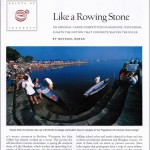 Like a Rowing Stone Download PDF
Like a Rowing Stone Download PDF
An unusual canoe competition in Madison, Wisconsin, floats the notion that concrete waives the rules
It’s barely daybreak in Madison, Wisconsin, but John Gilbert has already worked up a sweat. The 54-year-old, self-described concrete connoisseur is pacing the southern shore of Lake Mendota, which borders the sprawling University of Wisconsin campus. On this summer weekend, the university is hosting the 15th Annual National Concrete Canoe Competition, a collegiate event Gilbert hasn’t missed since 1990. At the moment, he’s inspecting 25 slender canoes—one from each contending school—neatly aligned at the water’s edge.
University of Alabama in Huntsville, invited me to the competition, I envisioned burly jocks paddling half-ton stone bathtubs in a losing battle to keep them afloat. In the early days, this scenario was not so far-fetched. Today, the boats are sleek and refined, painted in brilliant school colors and nearly identical in shape and size to their conventional aluminum and fiberglass cousins. Yet most of these craft are about 90 percent concrete. (Race rules require that participants leave a strip of canoe midsection unpainted so that judges can check out the concrete for themselves.) Student competitors decide which ingredients they will add to portland cement to make the concrete mixture. They have experimented with dozens of odd materials, from tiny glass orbs called microballoons to rice, perlite, silica fume and a wispy filler dubbed K37.
The 20-foot-long canoes are digitally sculpted on computers, then formed in intricate molds; they can cost up to $120,000 to design and build. They are not only strong and superlight—weighing between 70 and 130 pounds—but some of them are even flexible. “We could make these boats lighter,” says Gilbert, an undisputed authority on the subject. “But I’m not sure that would be better because they’d wobble too much.”
Alabama’s most recent prototype is a 72-pound canoe that behaves something like a coiled spring. During each paddle stroke, the pressure of the water against the concrete hull compresses it slightly. When canoeists pull their paddles from the water, the hull expands, releasing energy and pushing the canoe forward.
More than 250 civil engineering students from 25 universities in the United States, Mexico and Canada have come to Madison for the four-day event. The 6-foot-1-inch Gilbert dashes from one team to the next, peppering competitors with questions about additives they’ve mixed into their cement and how they’ve shaped their molds. He even buttonholes paddlers just off the lake, eager to learn if their canoes performed better in calm water or in a slight chop.
Gilbert publishes this information on his Web site, ConcreteCanoe.org, which bills itself as “the world’s largest and most comprehensive data base on concrete canoeing.” Under his leadership, the University of Alabama has won five national concrete canoe championships—more than any other school—and a total of 12 Southeast division league titles. This year, however, the team was eliminated during oral presentations at the regional competitions because a computer software glitch fouled up their presentation.
Intent on reclaiming the national title next year, Gilbert and four members of his Alabama team made the 750-mile road trip from Huntsville to Madison expressly to check out—and videotape—the competition. “If I were a betting person, I’d put money on Clemson University,” says Sarah Yeldell, one of Gilbert’s students, “even though they are our nemesis.” She insists that intelligence gathering is common—it’s almost expected—and that it keeps the competition fierce.
By midmorning on race day, temperatures top 90 degrees F and the air is stagnant and sticky. Sunburned spectators crowd the lakefront, swaying to the rhythms of New Age and hip-hop music blaring over the PA system. Gilbert can be found at Clemson’s camp, scribbling on a pad and snapping photographs with a digital camera.
A little later, he times the 600-meter slalom/endurance race, in which paddlers deftly navigate seven tightly spaced buoys with agility, then charge down a 500-meter straightaway. “Seconds are really critical now,” he says as Clemson and the University of Florida sprint neck and neck to the finish line.
In a 200-meter sprint, a four-person crew (two men and two women) paddles furiously, gunwales just inches from the waterline. The slightest mistake can upset a canoe. “Our boat started bouncing from the rhythm of the paddlers,” a drenched Ryan Taylor of Colorado State recounts after his team sportingly swims their swamped boat across the finish line. “I didn’t see it coming until there was a wall of water on top of us.”
At the end of the day, the Clemson crew has indeed prevailed. Gilbert credits its success to a flawless paddling technique and superior engineering. As the Clemson team accepts its trophy, I wonder what the native Ho-chunk Indians, who traversed the region’s waterways in dugout canoes almost two centuries ago, would have thought about this concrete model. I doubt they ever considered plastering an adhesive mixture of pebbles and lake silt to their keels.
Gilbert says the material’s versatility might one day yield concrete airplanes, submarines, clothing and sneakers. Before long, he says, flexible concrete spans will hold up earthquake-proof bridges. Self-healing concrete will repair chips and cracks in construction projects. “The new generation of concrete could be designed to act like rubber when it’s punctured,” he says, evoking the image of a sidewalk that can fill its own cracks. But what really excites Gilbert is his belief that innovations like these may cement the University of Alabama’s sixth national championship.
Copyright © Michael Behar. All Rights Reserved.
